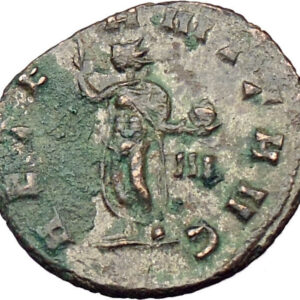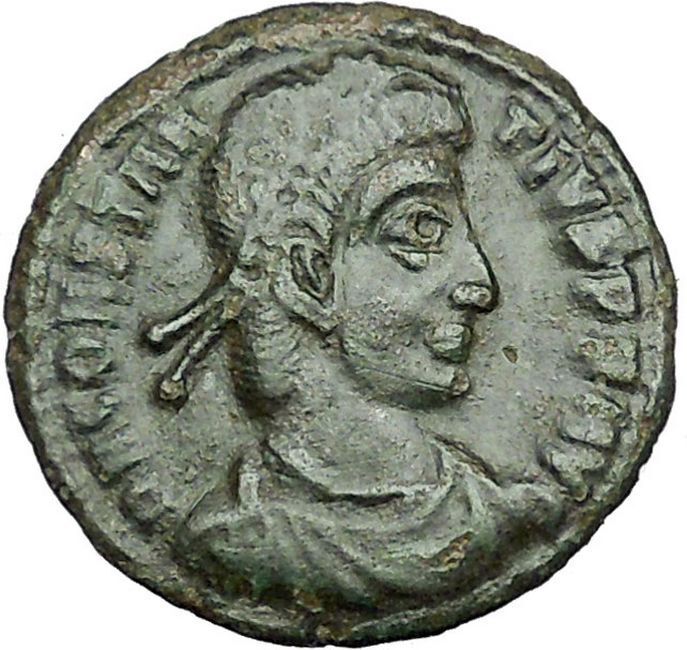|
Constantine II ‘Junior’ – Caesar: 316-337 A.D. and Roman Emperor: 337-340 A.D.
Son of Constantine I ‘The Great’
Bronze AE3 16mm (2.77 grams) Antioch mint, struck 330-335 A.D.
Reference: RIC VII 87
Reference: RIC 87 (VII, Antioch)
CONSTANTINVS IVN NOB C, Laureate, cuirassed bust right.
GLORIA EXERCITVS / SMANЄ, Two soldiers standing on either side of two standards.
You are bidding on the exact item pictured, provided with a Certificate of Authenticity and Lifetime Guarantee of Authenticity.
 The military of ancient Rome, according to Titus Livius, one of the more illustrious historians of Rome over the centuries, was a key element in the rise of Rome over “above seven hundred years” from a small settlement in Latium to the capital of an empire governing a wide region around the shores of the Mediterranean, or, as the Romans themselves said, ”mare nostrum”, “our sea.” Livy asserts The military of ancient Rome, according to Titus Livius, one of the more illustrious historians of Rome over the centuries, was a key element in the rise of Rome over “above seven hundred years” from a small settlement in Latium to the capital of an empire governing a wide region around the shores of the Mediterranean, or, as the Romans themselves said, ”mare nostrum”, “our sea.” Livy asserts
“… if any people ought to be allowed to consecrate their origins and refer them to a divine source, so great is the military glory of the Roman People that when they profess that their Father and the Father of their Founder was none other than Mars, the nations of the earth may well submit to this also with as good a grace as they submit to Rome’s dominion.”
Titus Flavius Josephus, a contemporary historian, sometime high-ranking officer in the Roman army, and commander of the rebels in the Jewish revolt, describes the Roman people as if they were “born ready armed.” At the time of the two historians, Roman society had already evolved an effective military and had used it to defend itself against the Etruscans, the Italics, the Greeks, the Gauls, the maritime empire of Carthage, and the Macedonian kingdoms. In each war it acquired more territory until, when civil war ended the Roman Republic, nothing was left for the first emperor, Augustus, to do except declare it an empire and defend it.
The role and structure of the military was then altered during the empire. It became less Roman, the duties of border protection and territorial administration being more and more taken by foreign mercenaries officered by Romans. When they divided at last into warring factions the empire fell, unable to keep out invading armies.
 During the Roman Republic, the function of the military was defined as service to the ”Senatus Populusque Romanus” – an agency designated by ‘SPQR’ on public inscriptions. Its main body was the senate, which met in a building still extant in the forum of Rome. Its decrees were handed off to the two chief officers of the state, the consuls. They could levy from the citizens whatever military force they judged was necessary to execute such decree. This conscription was executed through a draft of male citizens assembled by age class. The officers of the legion were tasked with selecting men for the ranks. The will of the SPQR was binding on the consuls and the men, with the death penalty often assigned for disobedience or failure. The men were under a rigorous code, known now for its punitive crucifixion. During the Roman Republic, the function of the military was defined as service to the ”Senatus Populusque Romanus” – an agency designated by ‘SPQR’ on public inscriptions. Its main body was the senate, which met in a building still extant in the forum of Rome. Its decrees were handed off to the two chief officers of the state, the consuls. They could levy from the citizens whatever military force they judged was necessary to execute such decree. This conscription was executed through a draft of male citizens assembled by age class. The officers of the legion were tasked with selecting men for the ranks. The will of the SPQR was binding on the consuls and the men, with the death penalty often assigned for disobedience or failure. The men were under a rigorous code, known now for its punitive crucifixion.
The consular duties were of any type whatever: military defense, police work, public hygiene, assistance in civil disaster, health work, agriculture, and especially construction of public roads, bridges, aqueducts, buildings, and the maintenance of such. The soldiers were kept busy doing whatever service needed to be done: soldiering, manning vessels, carpentry, blacksmithing, clerking, etc. They were trained as required, but also previous skills, such as a trade, were exploited. They brought to the task and were protected by the authority of the state.
The military’s campaign history stretched over 1300 years and saw Roman armies campaigning as far east as Parthia (modern-day Iran), as far south as Africa (modern-day Tunisia) and Aegyptus (modern-day Egypt) and as far north as Britannia (modern-day England, south Scotland, and Wales). The makeup of the Roman military changed substantially over its history, from its early history as an unsalaried citizen militia to a later professional force, the Imperial Roman army. The equipment used by the military altered greatly in type over time, though there were very few technological improvements in weapons manufacture, in common with the rest of the classical world. For much of its history, the vast majority of Rome’s forces were maintained at or beyond the limits of its territory, in order to either expand Rome’s domain, or protect its existing borders. Expansions were infrequent, as the emperors, adopting a strategy of fixed lines of defense, had determined to maintain existing borders. For that purpose they constructed extensive walls and created permanent stations that became cities.

Constantine II ‘Junior’ – Caesar: 316-337 A.D. and Roman Emperor: 337-340 A.D.
| Son of Constantine the Great and Fausta | Brother of Constantius II, Constans, Constantina (wife of Hanniballianus & Constantius Gallus) and Helena the Younger (wife of Julian II) | Half-brother of Crispus | Half-cousin of Delmatius, Hanniballianus, Constantius Gallus, Julian II, Licinius II and Nepotian | Grandson of Constantius I Chlorus, Helena, Maximian and Eutropia | Uncle of Constantia (wife of Gratian) |
Constantine II (Latin: Flavius Claudius Constantinus Augustus; January/February 316 – 340) was Roman Emperor from 337 to 340. Son of Constantine the Great and co-emperor alongside his brothers, his attempt to exert his perceived rights of primogeniture led to his death in a failed invasion of Italy in 340.
The eldest son of Constantine the Great and Fausta, after the death of his half-brother Crispus, Constantine II was born in Arles in February 316 and raised as a Christian. On 1 March 317, he was made Caesar. In 323, at the age of seven, he took part in his father’s campaign against the Sarmatians. At age ten, he became commander of Gaul, following the death of Crispus. An inscription dating to 330 records the title of Alamannicus, so it is probable that his generals won a victory over the Alamanni. His military career continued when Constantine I made him field commander during the 332 campaign against the Goths.
Following the death of his father in 337, Constantine II initially became emperor jointly with his brothers Constantius II and Constans, with the Empire divided between them and their cousins, the Caesars Dalmatius and Hannibalianus. This arrangement barely survived Constantine I’s death, as his sons arranged the slaughter of most of the rest of the family by the army. As a result, the three brothers gathered together in Pannonia and there, on 9 September 337, divided the Roman world between themselves. Constantine, proclaimed Augustus by the troops received Gaul, Britannia and Hispania.
He was soon involved in the struggle between factions rupturing the unity of the Christian Church. The Western portion of the Empire, under the influence of the Popes in Rome, favored Catholicism over Arianism, and through their intercession they convinced Constantine to free Athanasius, allowing him to return to Alexandria. This action aggravated Constantius II, who was a committed supporter of Arianism.
Constantine was initially the guardian of his younger brother Constans, whose portion of the empire was Italia, Africa and Illyricum. Constantine soon complained that he had not received the amount of territory that was his due as the eldest son. Annoyed that Constans had received Thrace and Macedonia after the death of Dalmatius, Constantine demanded that Constans hand over the African provinces, to which he agreed in order to maintain a fragile peace. Soon, however, they began quarreling over which parts of the African provinces belonged to Carthage, and thus Constantine, and which belonged to Italy, and therefore Constans.
Further complications arose when Constans came of age and Constantine, who had grown accustomed to dominating his younger brother, would not relinquish the guardianship. In 340 Constantine marched into Italy at the head of his troops. Constans, at that time in Dacia, detached and sent a select and disciplined body of his Illyrian troops, stating that he would follow them in person with the remainder of his forces. Constantine was engaged in military operations and was killed in an ambush outside Aquileia. Constans then took control of his deceased brother’s realm.
|





 The military of ancient Rome, according to Titus Livius, one of the more illustrious historians of Rome over the centuries, was a key element in the rise of Rome over “above seven hundred years” from a small settlement in Latium to the capital of an empire governing a wide region around the shores of the Mediterranean, or, as the Romans themselves said, ”mare nostrum”, “our sea.” Livy asserts
The military of ancient Rome, according to Titus Livius, one of the more illustrious historians of Rome over the centuries, was a key element in the rise of Rome over “above seven hundred years” from a small settlement in Latium to the capital of an empire governing a wide region around the shores of the Mediterranean, or, as the Romans themselves said, ”mare nostrum”, “our sea.” Livy asserts During the Roman Republic, the function of the military was defined as service to the ”Senatus Populusque Romanus” – an agency designated by ‘SPQR’ on public inscriptions. Its main body was the senate, which met in a building still extant in the forum of Rome. Its decrees were handed off to the two chief officers of the state, the consuls. They could levy from the citizens whatever military force they judged was necessary to execute such decree. This conscription was executed through a draft of male citizens assembled by age class. The officers of the legion were tasked with selecting men for the ranks. The will of the SPQR was binding on the consuls and the men, with the death penalty often assigned for disobedience or failure. The men were under a rigorous code, known now for its punitive crucifixion.
During the Roman Republic, the function of the military was defined as service to the ”Senatus Populusque Romanus” – an agency designated by ‘SPQR’ on public inscriptions. Its main body was the senate, which met in a building still extant in the forum of Rome. Its decrees were handed off to the two chief officers of the state, the consuls. They could levy from the citizens whatever military force they judged was necessary to execute such decree. This conscription was executed through a draft of male citizens assembled by age class. The officers of the legion were tasked with selecting men for the ranks. The will of the SPQR was binding on the consuls and the men, with the death penalty often assigned for disobedience or failure. The men were under a rigorous code, known now for its punitive crucifixion.





